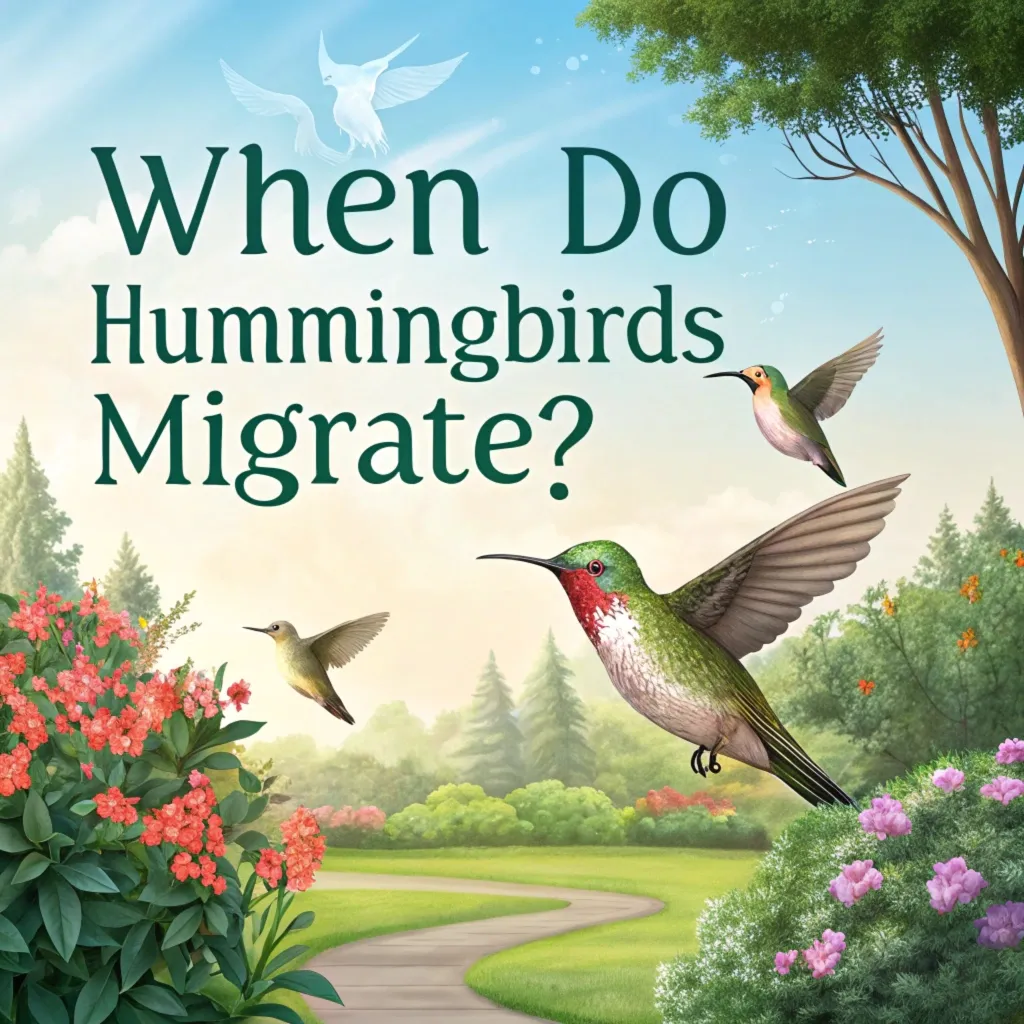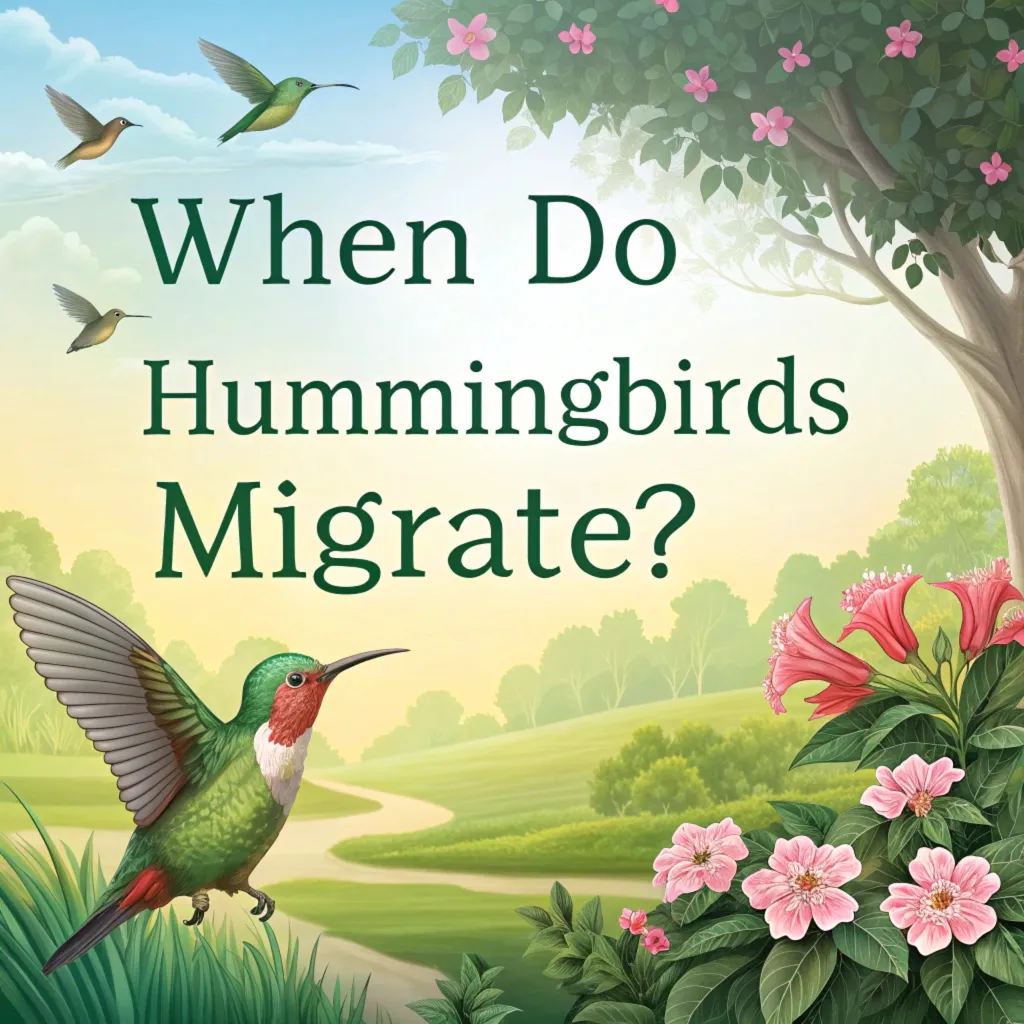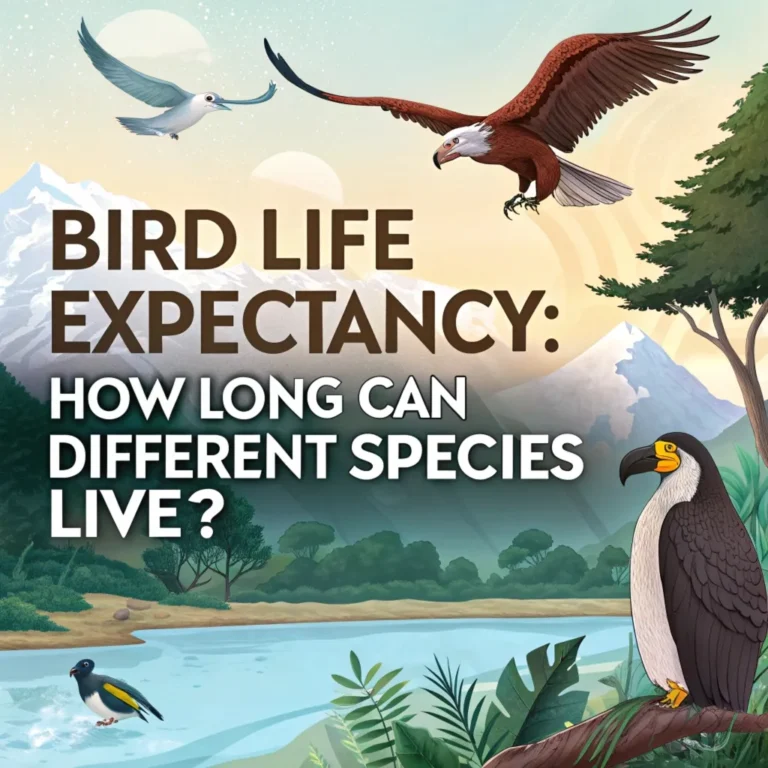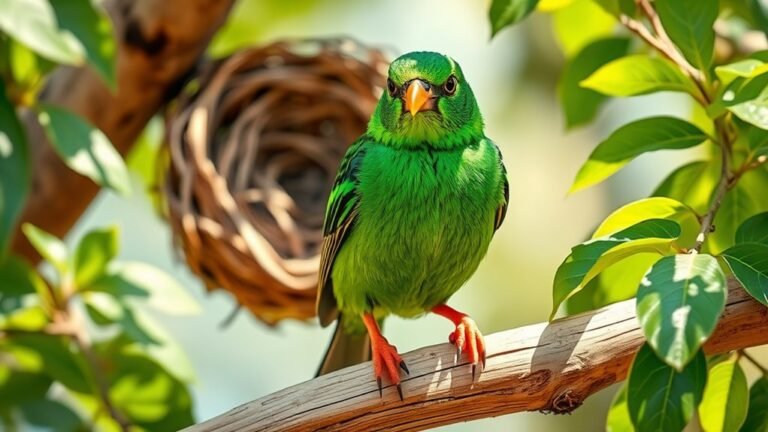When Do Hummingbirds Migrate? Key Timing Insights for Observers
Hummingbirds captivate bird enthusiasts with their tiny size and remarkable migration journeys.
This post explores the key timing insights for hummingbird migration, helping observers prepare for these aerial acrobats’ arrivals and departures.
We delve into the patterns of spring and fall migrations, focusing on different species and their unique routes.

Key Takeaways: Hummingbird Migration Essentials
- Spring migration typically starts in late January to mid-March for most North American hummingbirds
- Males usually arrive at breeding grounds about a week earlier than females
- Fall migration generally begins in August and September
- Ruby-throated Hummingbirds are the primary species in eastern North America
- Climate change is affecting migration patterns, with earlier departures from wintering grounds
- Different species follow varied migration routes, including the Pacific Flyway and Rocky Mountain chain
- Age and sex of hummingbirds influence their migration timing and routes
- Rufous Hummingbirds have one of the longest migrations relative to their body size
- Observers should prepare feeders by early March in the Southeast and late April in the Northeast
- Hummingbirds rely on tail winds and stopover sites with abundant food for successful migration
The intricate dance of hummingbird migration is a testament to nature’s precision. These tiny avian marvels navigate vast distances with remarkable accuracy, guided by internal clocks and environmental cues.
Understanding their journey not only enriches our appreciation for these creatures but also helps us support their survival in a changing world.
Observers play a crucial role in tracking and supporting hummingbird migration. By providing feeders and native plants, we can create vital refueling stations along their routes.
Spring Migration Kickoff
Hummingbirds begin their spring migration as early as late January. The first arrivals typically reach the southern United States by mid-March.
Male hummingbirds usually lead the migration, arriving at breeding grounds about a week before females.
The spring migration is a critical time for hummingbirds. They must time their arrival to coincide with the blooming of nectar-producing flowers and the emergence of insects.
This synchronization is essential for their survival and successful breeding.
Climate change is increasingly affecting the timing of spring migration. Warmer temperatures may cause flowers to bloom earlier, potentially creating a mismatch between hummingbird arrival and food availability.
Ruby-throated Hummingbird Migration
The Ruby-throated Hummingbird dominates the eastern two-thirds of North America. These birds winter in areas from southern Mexico to Costa Rica.
In spring, they reach the Gulf Coast by early March and gradually move northward.
Ruby-throated Hummingbirds face a daunting challenge during their migration. Many must cross the Gulf of Mexico, a non-stop flight of up to 500 miles that can take 18-22 hours. This incredible feat requires careful preparation and favorable weather conditions.
Observers in the eastern United States can expect to see Ruby-throated Hummingbirds arrive in their area between late March and early May, depending on latitude.
Climate Change Impact
Climate change is altering hummingbird migration patterns. Warmer conditions on wintering grounds are causing earlier departures.
Interestingly, hummingbirds now spend more time on the Gulf Coast, possibly to recover from their Gulf of Mexico crossing.
The effects of climate change on hummingbird migration are complex and ongoing. Changes in temperature and precipitation patterns can alter the timing of flower blooms and insect emergence, potentially creating mismatches between hummingbirds and their food sources.
Researchers are closely monitoring these changes to better understand how hummingbirds are adapting and what conservation measures may be necessary to support their populations.
Preparing for Hummingbird Arrivals
For observers eager to welcome hummingbirds, timing is crucial. In the Southeast, it’s best to set up nectar feeders by early March. Northeastern observers should prepare by late April.
Creating a hummingbird-friendly environment goes beyond just providing feeders.
Planting native nectar-producing flowers, maintaining water sources, and avoiding pesticides can all help support these tiny migrants during their journey and breeding season.
Regular cleaning and maintenance of feeders is essential to prevent the spread of diseases among hummingbirds.
Fall Migration Patterns
Hummingbirds start their southward journey in August and September. They follow a pattern of early morning feeding, midday travel, and late afternoon foraging to maintain their body weight.
The fall migration is less rushed than the spring journey. Hummingbirds take more time to build up fat reserves, often doubling their body weight before long flights.
This slower pace allows for more flexibility in response to weather conditions and food availability.
Observers may notice an increase in hummingbird activity at feeders during fall migration as birds fuel up for their journey.
Species-Specific Migration Routes
Different hummingbird species follow distinct migration routes:
- Rufous, Calliope, and Black-chinned Hummingbirds use the “Pacific Flyway” or “floral highway” along the western United States.
- Broad-tailed Hummingbirds migrate from central Mexico to breeding grounds in the western United States and Canada.
These migration routes have evolved over thousands of years, shaped by geography, climate, and the availability of food resources.
Each species has adapted to take advantage of specific corridors that offer the best chances for survival during their long journeys.
Understanding these routes helps conservationists identify critical habitats and stopover sites that need protection to support hummingbird populations.
Rufous Hummingbird: A Marathon Migrator
The Rufous Hummingbird undertakes one of the longest migrations relative to its body size. These birds travel from Alaska to Mexico, covering nearly 4,000 miles.
The incredible journey of the Rufous Hummingbird is a testament to the resilience and adaptability of these tiny birds.
Their migration takes them through a variety of habitats, from coastal regions to high mountain meadows, requiring them to adjust to changing conditions and food sources along the way.
Researchers are studying the Rufous Hummingbird’s migration patterns to better understand how climate change and habitat loss may be affecting their populations.
Age and Sex Differences in Migration
Research reveals that age and sex significantly influence hummingbird migration patterns:
- Adult males typically migrate first
- Adult females follow about two weeks later
- Young birds of both sexes migrate last
These differences in migration timing have evolved to maximize breeding success and survival.
Adult males arrive first to establish territories, while females and young birds benefit from more developed food sources later in the season.
Understanding these patterns helps observers predict when different groups of hummingbirds might appear in their area during migration.
Factors Influencing Migration
Hummingbirds decide to migrate based on several factors:
- Changes in daylight duration
- Abundance of flowers, nectar, and insects
- Instinct
The interplay of these factors creates a complex decision-making process for hummingbirds.
While instinct plays a significant role, the birds also show remarkable flexibility in responding to environmental cues and local conditions.
Researchers are continually studying how these factors interact and how they might be affected by climate change and habitat alterations.
Migration Challenges
Hummingbirds face numerous challenges during migration:
- Cold fronts over the Gulf of Mexico create difficult flying conditions
- Lack of food and shelter over open water
These challenges highlight the incredible resilience of hummingbirds. Their ability to navigate these obstacles is a testament to their evolutionary adaptations and the importance of maintaining suitable habitats and food sources along their migration routes.
Conservation efforts focused on preserving key stopover sites and creating habitat corridors can help mitigate some of these challenges for migrating hummingbirds.
Hummingbird Migration Strategies
These tiny birds employ remarkable strategies for successful migration:
- Flying low to spot food sources
- Using tail winds to conserve energy
- Gaining 25-40% of their body weight before migration
The sophisticated strategies used by hummingbirds during migration demonstrate their incredible adaptability and efficiency.
These birds have evolved to maximize their chances of survival during long, energy-intensive journeys.
Understanding these strategies helps researchers and conservationists develop more effective measures to support hummingbird populations during migration.
Observing Hummingbird Migration
Citizen science projects like eBird allow observers to contribute to hummingbird migration research.
These efforts have revealed that hummingbirds often change their migration routes from year to year, possibly in response to food availability.
Participating in citizen science projects not only contributes to our understanding of hummingbird migration but also helps foster a deeper connection between people and nature. Observers can play a crucial role in tracking changes in migration patterns over time.
Regular monitoring and reporting of hummingbird sightings can help identify trends and potential conservation needs for these fascinating birds.
Hummingbird Conservation During Migration
To support hummingbirds during migration:
- Maintain nectar feeders from early spring through fall
- Plant native flowering plants that provide natural nectar sources
- Avoid using pesticides that may harm hummingbirds or their insect prey
Conservation efforts for hummingbirds extend beyond just providing food. Creating and preserving suitable habitats along migration routes is crucial for the long-term survival of these species.
This includes protecting natural areas and encouraging the use of native plants in urban and suburban landscapes.
Educating the public about the importance of hummingbirds and their migration is key to fostering widespread support for conservation efforts.
FAQs
How fast do hummingbirds migrate?
Hummingbirds can travel up to 23 miles in a single day during migration.
Do all hummingbirds migrate?
Not all hummingbirds migrate. Some species in areas like California, the upper Pacific coast, and parts of the Gulf and Atlantic coasts remain year-round.
How do hummingbirds prepare for migration?
Hummingbirds prepare for migration by gaining 25-40% of their body weight to fuel their long journey.
What is the longest hummingbird migration?
The Rufous Hummingbird has one of the longest migrations relative to its body size, traveling up to 3,900 miles from Alaska to Mexico.
How does climate change affect hummingbird migration?
Climate change is causing hummingbirds to leave their wintering grounds earlier and spend more time recuperating along the Gulf Coast during spring migration.

Joyce is the passionate founder of Chirping Hearts, a website dedicated to sharing her love for birds and providing valuable information about avian life. With a background in ornithology and years of experience in birdwatching, Joyce aims to inspire others to appreciate the beauty and diversity of birds. Through her engaging articles and guides, she hopes to foster a community of bird enthusiasts who share her enthusiasm for these incredible creatures. When she’s not writing, Joyce enjoys exploring nature trails and observing birds in their natural habitats.







